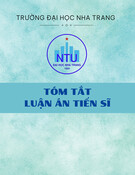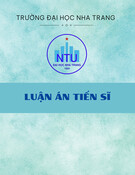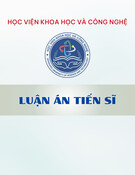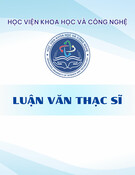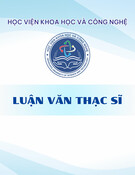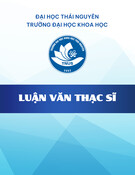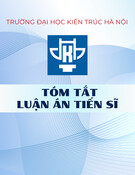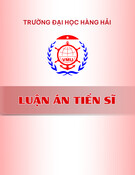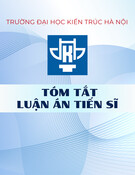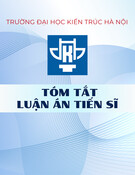
MINISTRY OF EDUCATION AND
TRAINING
VIETNAM ACADEMY
OF SCIENCE AND TECHNOLOGY
GRADUATE UNIVERSITY SCIENCE AND TECHNOLOGY
---- ----
CAO VAN LUONG
THE STUDY ON SEAGRASS COMMUNITIES
AND CARBON STORAGE CAPACITY OF THEM
IN SOME TYPICAL COASTAL LAGOONS
IN THE CENTRAL OF VIETNAM
Major: Botany
Code: 9420111
SUMMARY OF BIOLOGY DOCTORAL THESIS
Hanoi, 2019

The thesis is completed at: Graduate University Science and Technology -
Vietnam Academy of Science and Technology
Suppervisors : Prof. Dr. Dam Duc Tien
Dr. Tran Thi Phuong Anh
Reviewer 1: …
Reviewer 2: …
Reviewer 3: ….
The thesis shall be defended in front of the Thesis Committee at Academy
Level at Graduate University Science and Technology - Vietnam
Academy of Science and Technology
at…………………………… 2019
The thesis can be found at:
- the Library of Graduate University Science and Technology
- the National Library.

LIST OF PUBLISHED OF THE AUTHOR
RELATING TO THE THESIS
1. Cao Văn Lương, Đàm Đức Tiến, Nguyễn Thị Nga, 2018. Quần xã thực vật thủy
sinh đầm phá Tam Giang – Cầu Hai. Tạp chí Khoa học và Công nghệ Biển (đã
phản biện, đang chờ bản in).
2. Cao Văn Lương, Nguyễn Thị Nga, 2017. Bước đầu đánh giá khả năng lưu trữ
cacbon của cỏ biển qua sinh khối tại đầm Thị Nại, tỉnh Bình Định. Tạp chí Khoa
học và Công nghệ Biển; Tập 17, Số 1; 2017: 63-71.
3. Nguyễn Thị Thu, Cao Văn Lương, Đỗ Văn Mười, 2014. Phục hồi hệ sinh thái
thảm cỏ biển bằng mô hình sắp xếp lại hệ thống nò sáo tại đầm phá Tam Giang –
Cầu Hai. Tuyển tập Hội nghị Khoa học toàn quốc về Sinh học biển và Phát triển
bền vững lần thứ 2; tiểu ban Đa dạng sinh học và Bảo tồn biển. Nhà xuất bản Khoa
học tự nhiên và Công nghệ, tr. 227 – 231.
4. Cao Văn Lương, Đàm Đức Tiến, Nguyễn Đức Thế, Nguyễn Văn Quân, 2014.
Thành phần loài và phân bố cỏ biển tại đầm Nại – Ninh Thuận. Tuyển tập Hội
nghị Khoa học toàn quốc về Sinh học biển và Phát triển bền vững lần thứ 2; tiểu
ban Đa dạng sinh học và Bảo tồn biển. Nhà xuất bản Khoa học tự nhiên và Công
nghệ, tr. 131 – 137.

1
INTRODUCTION
1. The necessery of the thesis
Seagrasses are flowering plants and living under marine water.
Although, species diversity of seagrass is not so high, but the ecosystem
functions of seagrass are equally important when comparing to coral reefs
and mangroves (Nguyen Van Tien et al., 2004).
Recently, seagrass has been recognized for their carbon storage capacity
and estimated about 19.9 Pg (1 petagram = 1015 grams) of organic carbon
over the world, this capacity is higher 3 times than tropical forest
(Fourqurean et al., 2012).
However, there are few specific studies on seagrass community
characteristics, the relationship between them with other inorganic and
organic factors, and in particular, there has been no research on the carbon
storage capacity of seagrass in Vietnam. From the above reasons, I take the
thesis with title: “The study on carbon storage capacity and
communitiescharacteristicsof seagrass beds in some typical coastal
lagoons in the central of Vietnam”.
2. Objectives
This study aims to provide basic knowledge of carbon storage capacity
and communities characteristics of seagrass beds in some typical coastal
lagoons in the central of Vietnam. These important knowledges will be
applied to activities of conservation, caculation of the carbon market, and
reducing CO2 emissions in the future in Vietnam.
The specific objectives:
1. To assess the community structure of seagrass beds in the Tam Giang
- Cau Hai lagoon (Thua Thien – Hue province), Thi Nai lagoon (Binh
Dinh province) and Nai lagoon (Ninh Thuan province);
2. To determine the biomass reserves of seagrass beds in the study areas;
3. To investigate the ability of seagrass beds on the storage organic
carbon (Corg) and the accumulation of CO2.
3. The main research contents
3.1. Study on the seagrass communities: species composition and
morphological, distribution, coverage areas. Establishment of the key
identifying of seagrasses in study areas.

2
3.2. Investigation and identification of quantitative characteristics of
seagrass species in the study area.
3.3. Determination of content (%OC) and Corg of seagrass species;
3.4. Evaluating carbon storage capacity of seagrass communities.
4. Structure of the thesis
The thesis consists of 129 pages, 2 pages in introduction, 28 pages in
overeview, 15 page in materials and methods, 69 pages of results and
discussion, 2 pages of conclusions and recommendations, 1 pages of
published , 12 pages in reference. The thesis has 16 tables, 35 figures and
charts, 137 references.
CHAPTER I. OVERVIEW
1.1. An overview of seagrasses
Seagrasses belonging to Anthophyta, Monocotyledoneae,
Hydrocharitales. A monocotyledon has two forms of reproductive:
dioecious and monoecious. Populations are maintained and developed
primarily by the development of shoots. Morphological characteristics of
seagrasses were described and compared by C. Den Hartog (1970) and C.
Phillips and G. Menez (1988).
1.2. Seagrass beds in the world
At present, there are 66 species of seagrass distributed over 600,000 km2
in the world (den Hartog, 2006). The number of species is not much, but
the seagrass bed is one of the most important marine ecosystems.
Moreover, the seagrass bed is an essential part of the solution to climate
change and can store twice as much carbon as temperate and tropical
forests (James Fourqurean (2012).
1.3. Previous studies in Vietnam
In Vietnam before 1995, seagrass was studied a little compared to other
marine fauna and flora groups. Pham Hoang Ho recorded the findings of
seagrass in Qui Nhon (1960) and in Phu Quoc (1985). Since 1996 the
study on seagrass has been officially promoted. The most prominent are
the studies of Nguyen Huu Dai (1999, 2002), Nguyen Van Tien (1999,
2000, 2003, 2006, 2008, 2013). From these studies, we have a basic

